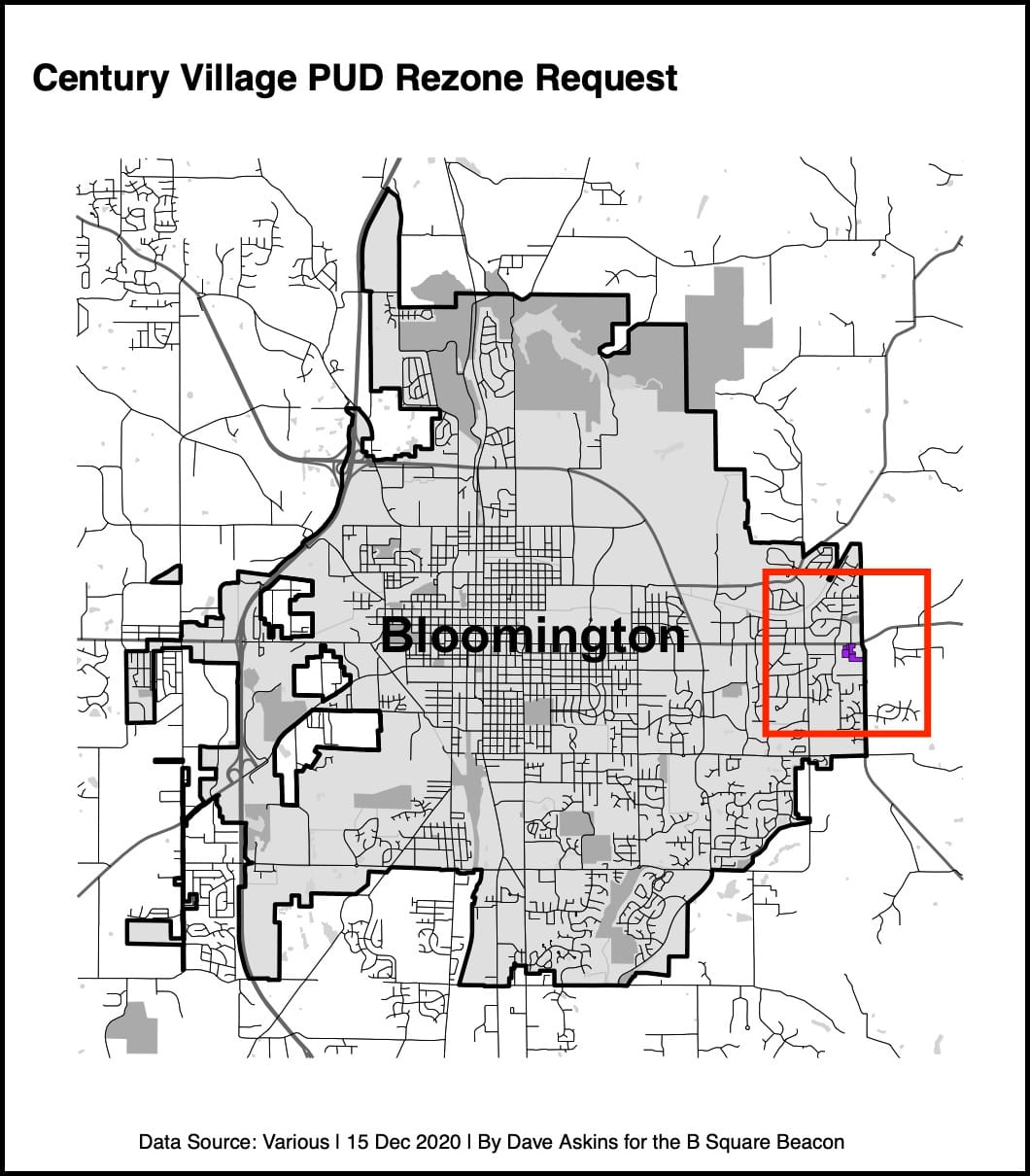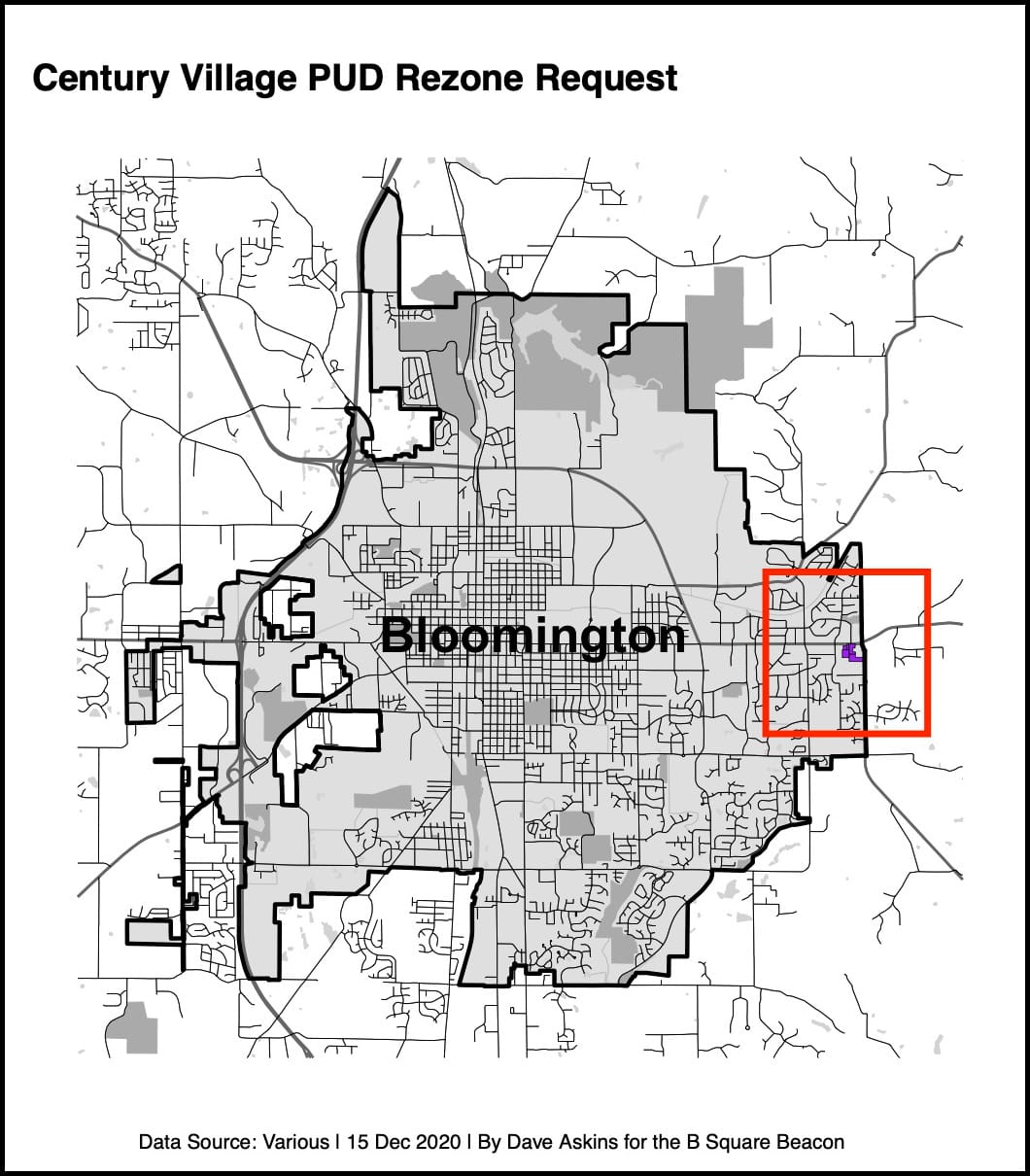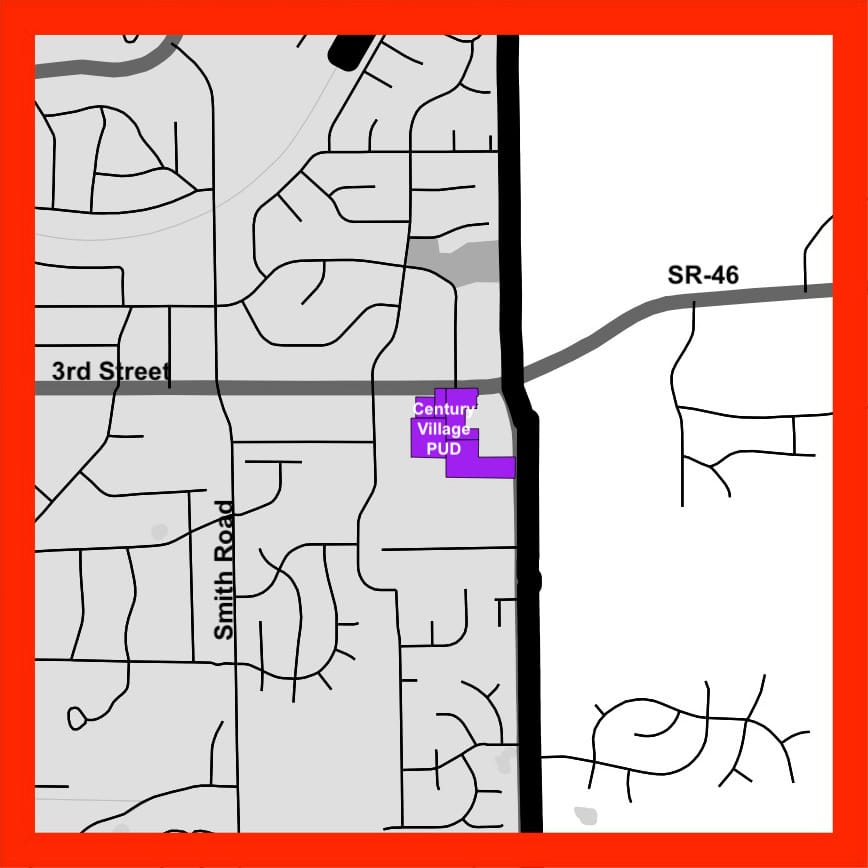Century Village gets rezoned on 7–2 vote as Bloomington city council debates question: Who is saying college students are not people?



A rezoning for a 10-acre parcel of land on the east edge of town, at the intersection of SR-46 (3rd Street) and SR-446, has been approved by Bloomington’s city council.
The council’s approved rezoning, which had been unanimously recommended by the plan commission, changed a planned unit development (PUD) to a mixed-use corridor (MC) district.
It’s the same zoning change recommended as a part of the citywide zone map revision project, which will land in front of the plan commission in early March. So the council’s approval on Wednesday could be analyzed as enacting something a few months earlier than might have been enacted anyway.
The impact of the zoning decision is that any proposal for a specific project that conforms with MC zoning, will be reviewed only by the plan commission, not by the city council.
Dissenting were Dave Rollo and Kate Rosenbarger.
Rollo was concerned about the fact that the council would lose any future ability to negotiate the specifics of a site plan. Rosenbarger found the conceptual site plan to be uninspiring, and questioned whether anyone would want to live such a place, where access to goods and services is not walkable.
A conceptual site plan for a project, which owner Bill Brown has a potential developer on board to construct, was included in the city council’s information packet. The concept shows multi-family housing to be constructed in four buildings with a mix of one- and two-bedroom apartments adding up to around 168 units, with about 240 bedrooms.
The council’s deliberations on Wednesday touched on a couple different considerations. They included the difference between zoning approval and site plan approval, along with the difference between PUD and base zoning
Also included in the mix were the attitudes of councilmembers towards college students.
College students came up as a topic in connection with a previous proposal for the site, which was made a couple of years ago as a revision to the existing PUD zoning district.
The council was asked in 2018 to consider rezoning the 10 acres to allow for a student-oriented housing development that would have included 590 bedrooms. On Nov. 14, 2018, the council voted down the rezoning at 1:32 a.m. on a tally of 0–8 with one abstention, from then-councilmember Chris Sturbaum.
At their Wednesday meeting, some councilmembers recalled the council’s previous decision, and described the site as inappropriate for college student housing.
Councilmember Steve Volan took the occasion to tick through some of his standard talking points. Those include the idea that most other Bloomington elected and appointed officials think college students should live separate from the rest of Bloomington residents: “God forbid that student housing should be allowed anywhere except in the new zone we have that is specifically dedicated for student housing, because students should live apart from non-students.”
Volan added, “It’s almost like students aren’t people.”
That led to rebuttals from other councilmembers and further reply from Volan. Councilmember Susan Sandberg had the final word on the topic. Sandberg said, “I, too, resent being categorized as someone who doesn’t want students to live in certain areas of the town. Because I accept the reality that they live everywhere.”
PUD versus base zoning
The city council’s approval of the rezoning does not constrain the site to be developed according to the conceptual site plan. A more intensive residential land use would be possible on the site, than is contemplated by the conceptual site plan.
When a PUD is considered, which is a kind of customized zoning, the council has the chance to negotiate the zoning specifications in enough detail that it’s similar a site plan approval. Other conditions, outside of a site plan, can also be imposed.
It was partly the potential for a more intense land use at the site, for which plan commission approval could be granted without further city council input, that made councilmember Dave Rollo reluctant to support Wednesday’s proposal.
Bloomington development services manager Jackie Scanlan responded to a question from Rollo by saying the plan staff had recommended approval of the 2018 request and that if something similar were to be proposed, she thought the plan staff would think it could be appropriate, “if done properly.”
Rollo said that adopting the base MC zoning district meant surrendering “an oversight role that the council should be involved in.” The oversight role is one that can be exercised in the PUD negotiation process, Rollo said. He added, “I’m not sure exactly what will occur here. I suspect that it’ll be something similar to what we actually rejected in the past, in just a different form.”
A point of agreement between Rollo and Volan was the fact that the general move away from PUD zoning districts to base zone would mean certain kinds of negotiations could not take place.
One of those negotiation points could be to make the zoning approval contingent on a contribution to the public transportation system. Future financial contributions to public transportation were negotiated points for the Collegiate Development Group’s project at the former Motel 6 on North Walnut, as well as for the Trinitas development in the West 17th and Arlington Road area.
Volan said, “I’m not sure what better way there is to fund buses. We know that bus money doesn’t grow on trees.” He added, “Even with the new Biden administration, it’s going to be some time before we can see real commitment to public transit.”
Councilmember Matt Flaherty recognized that the city council would have less leverage to affect projects, if the site plan simply met the requirements of the base zoning district. In that case, the plan commission could review a project without the city council’s involvement.
But Flaherty’s perspective was that if projects that meet zoning requirements are not the kind of projects the city council would like to see, then the council should change the zoning rules. “If we don’t like zoning rules, the idea is you make better zoning rules, better zoning code and let people follow it,” Flaherty said.
If that approach is taken, Flaherty added, “It’s our duty to work with staff to…change the rules, as opposed to negotiating properties that come before us.”
Who thinks college students are not people?
Here’s a transcript of the thread of councilmember deliberations on the topic of attitudes towards college students. Several other councilmember speaking turns have been elided and are glossed with an ellipsis […].
Rollo: This looks suspiciously like what we saw some a year or so ago, which was a large student apartment complex on the periphery of the city.
[The vote was 0-8-1 on Nov. 14, 2018. Volan joined the majority in voting no. It was councilmember Chris Sturbaum, who abstained, according to the meeting minutes.]
…
Sandberg: [W]ith respect to the project that was soundly defeated, because it was overly dense with a student-driven project that was clearly designed by a petitioner that was in the market for building student housing. …It wasn’t what we need in terms of the kind of housing that we need. It looks like this will be apartments, and the fact that they are one- and two-bedroom apartments, as opposed to those multi- four- and five-, I think that will attract the kind of individuals who need that kind of rental housing in that part of town, as the hospital site is going to be developed. …
…
Volan: A couple observations I have here. But more importantly, I think the ghost of the previous proposal still looms over this area. That project was more than a year ago, it was more like three years ago. And it was a much denser project, that would have funded public transit. But because it was student-focused housing, single-family non-student neighborhoods came from no nearer than a mile away to object to such a project in their neighborhood. It was defeated. It was on a major corridor, it was proposing public transit. The only thing that mattered was, god forbid, that it should be student housing. God forbid that student housing should be allowed anywhere except in the new zone we have that is specifically dedicated for student housing, because students should live apart from non-students. This seems to be the watchword of, I don’t know, everyone else I know in city hall. It’s almost like students aren’t people. You know, I hope that if there are students watching, Mr. President, I hope that they see that this is how the rest of the city talks about students as though they are “other.” As though they are from far away, as though they cannot be assimilated into our city. … But there was the hysteria around the potential student project. Was entirely out of proportion then. And the fact that we’re still echoing it to this day, it continues to be a shame on the city.
…
Rollo: Well, I certainly don’t regret my vote on the previous student housing complex on the periphery of the city. I think that students should be housed closer to campus, frankly. And I think that [the previous proposal] was a mistake. And it was seen to be, I think, well, by the majority. …I’m not fully comfortable with this. It’s a very large parcel. And the potential for this is large as well. And I’m not comfortable with the rezone in that what I see is surrendering an oversight role that the council should be involved in, which occurs during the PUD process. I would prefer that input with demonstrated public good and with a top quality development, and I’m not sure exactly what will occur here. I suspect that it’ll be something similar to what we actually rejected in the past, in just a different form. So I’ll be voting against this, this evening.
…
Flaherty: The one of the thing I’ll note about about students and student housing, generally, while I kind of share councilmember Volan’s general view that students are just members of our community, and half of it at that, and sort of belong, wherever they’d like to be, and everywhere, in every neighborhood. But sometimes we hear things like: We don’t need more student housing. Which, I get what the point of that kind of statement is, I think. But the counterpoint is: When you add, say, 1,000 bedrooms of student housing, that’s 1,000 students, if it is, in fact, students who live there, that aren’t living somewhere else.
…
Sims: I think it’s a mistake to broadly say that many of us on this council or in this city, characterize students as non-persons. I think that’s a gross mischaracterization. I think…one of the reasons part of our zoning code and zoning rules, in earmarking places that are properties closest to campus is so that they would be in proximity of campus and therefore better suited for student housing in that particular area. … So I just wanted to make that comment. I’m not interested in any debate or more rebuttal. But I personally do not consider students non-persons. I worked at Indiana University… [W]ithout those students, then I’m not so sure I would have had a career. I think many of us here would share that same sentiment. So I just really wanted to say that. I just don’t want everyone painted with the same brush, because many of us do not share that characterization.
…
Volan: I think I would wager that I’m the only member in the history of this august body that I know of, to ever have been a student while serving as a councilmember.
[Jeff Richardson was the first full-time IU student elected to the Bloomington city council, representing District 6, in 1975, taking office in 1976. Richardson earned his undergraduate degree in 1973 and was an IU law student when he was elected and started his city council service. Richardson earned his J.D. in 1977.]
I was finishing my undergraduate in my first term, I finished a graduate degree in the most recent term. Students have been half the population of the city of Bloomington since 1960. Yet there has never been an undergraduate member of the city council. Why does this matter? Well, we’re hearing tonight that, you know, students should be living closer to campus, that this is too far away. But the so called core-neighborhoods have vociferously opposed plexes precisely because of their fear of student housing increasing in their neighborhoods, which are the very areas close to campus. I have heard people saying tonight where students should live. There is an ongoing variation of standard as to how and where students should live. And I don’t have any hope anymore, of persuading the non-student population of the city, to think more holistically about students. To get rid of some of their assumptions about how all students are noisy, sloppy, slovenly drunk, because the vast majority of students aren’t, and they live among us, in all neighborhoods of town. But we’re certainly doing everything we can to corral them into certain parts of town, saying that they should live near campus. But really, it’s: They should live somewhere else. Somewhere that’s not where I can see them, because I’m not a student, and I don’t want to see them. So with all due respect to the expressions of concern that people have for students, I don’t think that any rational student listening to this conversation should should buy those arguments. It’s very clear that we have a de facto effort to keep students in a certain part of town.
…
Rollo: …I think that as you stated, President Sims, students have certain needs. One is to be close to campus. And this is certainly not close to campus. So, but I would say that councilmember Volan paints strawmen in arguments as well. …
…
Sandberg: I would just like to state the obvious, that in the city of Bloomington, we are a college town. Students have always lived everywhere. And students will continue to live everywhere. That’s the nature of this community, when over half the population at times are college students. The purpose that the plan commission and our planning staff and we, as council members, have is to provide a balance of housing. And we when we see a scale start to tip, you’re going to hear some pushback and feedback. All throughout the development of a comprehensive plan and the UDO, we heard: There’s too much student housing here, there, we need to put it perhaps in an area where it’s going to be less of a stress or a strain on other parts of the built environment. And may I remind you, we just approved [The Standard and the project at the site of the former Motel 6] along the Walnut corridor. So it is not that we are not thinking about the needs of students and their needs to have housing. And we’re well aware that they live within core neighborhoods, they live close to campus in residential areas. And they always will have that choice. And with this project that’s being built, anyone can live there, there are not restrictions on whether you’re a student or whether you are a single person or whether you are a professional couple, anyone can live in any apartment that is in this city. …I think I agree with you, Councilmember Rollo, that there are these strawman arguments that people who are concerned about where student housing goes. Which is largely driven by the free market, by the way…It’s not always up to us as to where people want to want to build things for the markets that they have done market research on as to what’s going to sell. I, too, resent being categorized as someone who doesn’t want students to live in certain areas of the town. Because I accept the reality that they live everywhere.




Comments ()